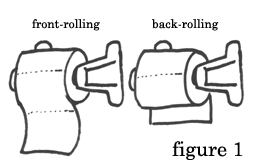The Physics of Toilet Paper
Anybody who has thought about toilet paper for more than a few moments has probably realized that there are only two ways to position a roll on the spindle: front-rolling and back-rolling (see figure 1). Once you become aware of this distinction you might even begin to develop an eye for whether a particular place rolls its paper forwards or backwards. "Is there a difference?" you ask. "Is this something I should care about?" you wonder. Well, I claim that not only is there a very important difference between front-rolling and back-rolling your toilet paper, one way is simply and clearly superior to the other.
 At first thought, most people would probably think that the two methods are roughly equivalent, or that the difference is merely a matter of preference. The fact that through my observations the proportion of front- and back-rolling is not significantly different (52% front, 42% back, 6% NA from 50 observations) would support this thought. But the two are not equivalent. Furthermore, unless a person has pathological preferences, front rolling is strictly better than back-rolling. It is not a matter of preference or of upbringing; the superiority of front-rolling is a matter of physics. At first thought, most people would probably think that the two methods are roughly equivalent, or that the difference is merely a matter of preference. The fact that through my observations the proportion of front- and back-rolling is not significantly different (52% front, 42% back, 6% NA from 50 observations) would support this thought. But the two are not equivalent. Furthermore, unless a person has pathological preferences, front rolling is strictly better than back-rolling. It is not a matter of preference or of upbringing; the superiority of front-rolling is a matter of physics.
Of the people I have asked, the people who prefer back-rolling do so either because it "looks nicer, cleaner" or "keeps the loose end from dangling about". While these are legitimate reasons for preferring back-rolling, inane aesthetic concerns are easily overshadowed by the gains from improved leverage. Rolls of flimsy white paper strung on spinning sconces have been considered an eyesore to bathroom decor for many decades, but how much of an improvement could hiding a loose end make to account for the significant decrease in efficiency. As far as the dangling goes - this reason is only defendable if the person has a pet that tends to unwind the roll whenever it gets a chance.
So what is this improved functionality that I keep referring to? It comes from the angle of the force applied when you rip the paper from the roll for use. If you front-roll your paper, you can hold the paper out parallel to the floor and yank perpendicular to the plane of spin (see figure 2). This ensures that the paper will rip at the first perforation not still on the roll. It also enables the dispensing individual to perform the maneuver one-handed. People who back-roll their paper are restricted to a downward pull, or a sideways pull off the bottom. Either way, the leverage you can achieve is much lower than the front-pulling maneuver -- and almost always requires two hands.
The following conclusion is obvious considering the above points: unless you have untamed creatures running around your bathroom, you ought to prefer front-rolling your toilet paper. But if my argument is so clear, why doesn't everybody do it this way? Why do so many people back-roll? I guess it is because "Life" doesn't come with an instruction manual, and people generally don't bother to take the time and think about the world around them.
ALB 4-12-02

|